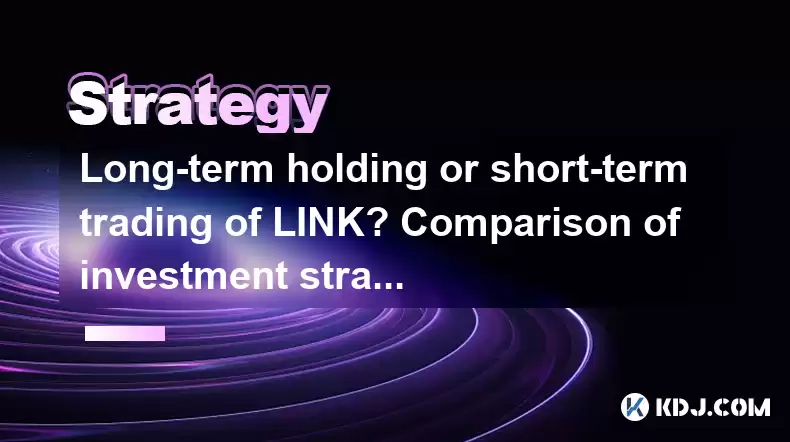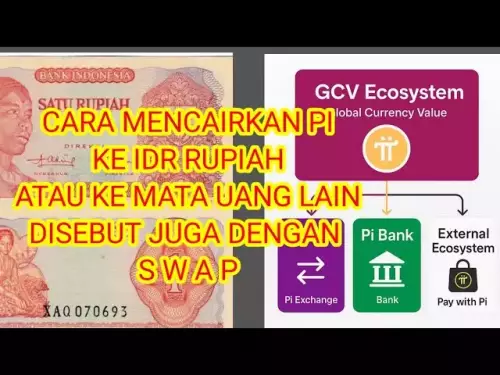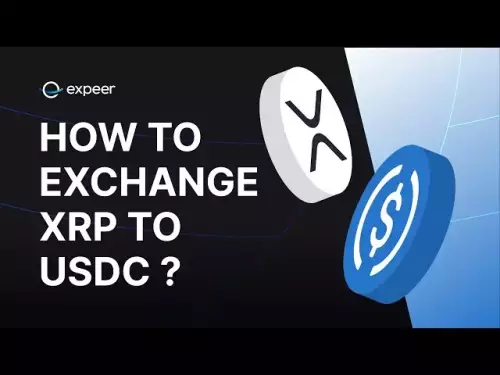-
 bitcoin
bitcoin $112715.707551 USD
-1.71% -
 ethereum
ethereum $4101.475385 USD
-3.01% -
 tether
tether $1.000644 USD
-0.02% -
 bnb
bnb $1207.619465 USD
-6.77% -
 xrp
xrp $2.501451 USD
-3.98% -
 solana
solana $202.947124 USD
-3.32% -
 usd-coin
usd-coin $1.000295 USD
0.04% -
 dogecoin
dogecoin $0.203884 USD
-4.47% -
 tron
tron $0.317154 USD
-1.72% -
 cardano
cardano $0.695009 USD
-4.43% -
 hyperliquid
hyperliquid $38.853961 USD
-8.23% -
 chainlink
chainlink $18.988674 USD
-4.64% -
 ethena-usde
ethena-usde $1.000233 USD
-0.03% -
 stellar
stellar $0.337050 USD
-3.63% -
 bitcoin-cash
bitcoin-cash $536.861728 USD
-1.28%
Long-term holding or short-term trading of LINK? Comparison of investment strategies
Long-term holding of LINK involves buying and holding for years, betting on its growth, while short-term trading seeks quick profits from price fluctuations.
Apr 29, 2025 at 11:42 pm

When considering whether to engage in long-term holding or short-term trading of Chainlink (LINK), it's essential to understand the distinct strategies and their implications. Long-term holding involves purchasing LINK and retaining it for an extended period, often years, with the expectation that its value will appreciate over time. Conversely, short-term trading entails buying and selling LINK within shorter time frames, such as days or weeks, to capitalize on price fluctuations. Each approach has its own set of advantages and risks, and the choice between them depends on various factors including investment goals, risk tolerance, and market analysis.
Understanding Long-Term Holding of LINK
Long-term holding of LINK is often favored by investors who believe in the long-term potential of the Chainlink network. Chainlink is a decentralized oracle network that provides real-world data to smart contracts on the blockchain. Investors who hold LINK for the long term are typically betting on the increasing adoption and integration of Chainlink's technology across various industries.
One of the primary advantages of long-term holding is the potential for significant returns over time. Historical data shows that cryptocurrencies like LINK can experience substantial growth over several years. For instance, those who held LINK from its early days have seen impressive returns as the project gained traction and partnerships.
However, long-term holding also comes with its challenges. The cryptocurrency market is highly volatile, and holding LINK for an extended period means enduring potential price swings without the ability to react quickly. Additionally, long-term holders must stay informed about the project's developments and the broader market trends to ensure their investment thesis remains valid.
Benefits and Risks of Short-Term Trading LINK
Short-term trading of LINK involves a more active approach, where traders aim to profit from the frequent price movements of the cryptocurrency. This strategy requires a keen understanding of market trends, technical analysis, and the ability to make quick decisions.
One of the main benefits of short-term trading is the potential for quick profits. Traders can capitalize on short-term price movements, which can be significant in the volatile crypto market. Additionally, short-term trading allows for greater flexibility, as traders can adjust their positions based on the latest market developments.
However, short-term trading also comes with higher risks. The crypto market can be unpredictable, and even experienced traders can incur losses. The need for constant monitoring and quick decision-making can also be stressful and time-consuming. Moreover, short-term trading often involves higher transaction fees, which can eat into profits.
Factors to Consider When Choosing Between Long-Term Holding and Short-Term Trading
When deciding between long-term holding and short-term trading of LINK, several factors should be considered. Investment goals play a crucial role. If the goal is to build wealth over time, long-term holding might be more suitable. On the other hand, if the goal is to generate quick profits, short-term trading could be the better option.
Risk tolerance is another critical factor. Long-term holding generally involves less risk compared to short-term trading, as it allows investors to weather short-term volatility. However, it requires patience and a strong belief in the project's long-term potential. Short-term trading, while potentially more lucrative, requires a higher risk tolerance and the ability to handle potential losses.
Market analysis is also essential. Long-term holders need to stay informed about Chainlink's developments, partnerships, and the overall crypto market trends. Short-term traders, on the other hand, need to be adept at technical analysis and stay updated on the latest market news to make informed trading decisions.
Practical Steps for Long-Term Holding of LINK
For those interested in long-term holding of LINK, here are some practical steps to consider:
- Research and Due Diligence: Before investing, thoroughly research Chainlink's technology, team, and roadmap. Understand the project's potential and the factors that could drive its growth.
- Diversify Your Portfolio: While believing in LINK's potential, it's wise to diversify your investments to mitigate risk. Consider allocating a portion of your portfolio to LINK while investing in other assets.
- Secure Storage: Use a hardware wallet or a reputable software wallet to securely store your LINK. Long-term holding requires safeguarding your assets against potential hacks or theft.
- Stay Informed: Regularly follow Chainlink's official channels, news outlets, and community forums to stay updated on the project's progress and any significant developments.
Practical Steps for Short-Term Trading of LINK
For those interested in short-term trading of LINK, here are some practical steps to consider:
- Set Up a Trading Account: Choose a reputable cryptocurrency exchange that supports LINK trading. Ensure the exchange has a user-friendly interface and robust security measures.
- Learn Technical Analysis: Familiarize yourself with technical analysis tools and indicators such as moving averages, RSI, and MACD. These tools can help you identify potential entry and exit points.
- Develop a Trading Plan: Create a clear trading plan that outlines your entry and exit strategies, risk management rules, and profit targets. Stick to your plan to avoid emotional trading decisions.
- Monitor the Market: Keep a close eye on LINK's price movements and market news. Use trading platforms that offer real-time data and alerts to stay informed about potential trading opportunities.
- Manage Risk: Use stop-loss orders to limit potential losses. Never invest more than you can afford to lose, and consider using only a small portion of your capital for short-term trading.
Comparing the Performance of Long-Term Holding and Short-Term Trading
To better understand the potential outcomes of long-term holding versus short-term trading of LINK, it's helpful to look at historical performance. Long-term holders who purchased LINK at its early stages have seen significant returns as the project grew and gained adoption. For example, those who bought LINK in 2017 and held until 2021 would have experienced substantial growth in their investment.
On the other hand, short-term traders who actively traded LINK during the same period could have also achieved profits by capitalizing on the cryptocurrency's volatility. However, the success of short-term trading depends heavily on the trader's skills and market timing. Some traders may have made profits, while others may have incurred losses.
Frequently Asked Questions
Q: Can I switch between long-term holding and short-term trading of LINK?A: Yes, it's possible to switch between long-term holding and short-term trading based on your investment goals and market conditions. However, it's important to have a clear strategy and understand the implications of each approach before making such a switch.
Q: How do taxes affect my decision to hold or trade LINK?A: Tax implications can vary depending on your jurisdiction. Generally, long-term holding may qualify for more favorable tax treatment compared to short-term trading, which is often taxed at a higher rate. It's advisable to consult with a tax professional to understand the specific tax implications in your region.
Q: What role does market sentiment play in deciding between long-term holding and short-term trading of LINK?A: Market sentiment can significantly influence both long-term holding and short-term trading decisions. Positive sentiment can drive up LINK's price, benefiting both long-term holders and short-term traders. Conversely, negative sentiment can lead to price drops, which short-term traders might capitalize on, while long-term holders need to remain patient and focused on the project's fundamentals.
Q: How important is it to stay updated on Chainlink's developments for both long-term holding and short-term trading?A: Staying updated on Chainlink's developments is crucial for both long-term holding and short-term trading. For long-term holders, understanding the project's progress and partnerships can reinforce their investment thesis. For short-term traders, news and developments can create trading opportunities based on market reactions.
Disclaimer:info@kdj.com
The information provided is not trading advice. kdj.com does not assume any responsibility for any investments made based on the information provided in this article. Cryptocurrencies are highly volatile and it is highly recommended that you invest with caution after thorough research!
If you believe that the content used on this website infringes your copyright, please contact us immediately (info@kdj.com) and we will delete it promptly.
- Tokenization Takes Center Stage: SEC-Registered Stock Tokens Reshape Finance
- 2025-10-15 22:25:13
- Bitcoin Seized, Transferred: A New York Minute on Crypto's Wild Ride
- 2025-10-15 22:25:13
- Milk & Mocha's $HUGS: Can This Crypto Presale Deliver a 100x Portfolio?
- 2025-10-15 22:30:01
- Memecoins Grow Up: $HUGS Presale Offers Real Utility
- 2025-10-15 22:45:13
- HUGS Launch, Crypto Bull Run, and a Perfect Storm Brewing?
- 2025-10-15 22:45:13
- Zero Knowledge Proof, Whitelists, and the Future of Blockchain Privacy
- 2025-10-15 22:30:01
Related knowledge

Practical parameter settings for a Bitcoin multi-timeframe moving average system
Sep 18,2025 at 10:54pm
Optimizing Timeframe Combinations for Bitcoin Trading1. Selecting appropriate timeframes is crucial when building a multi-timeframe moving average sys...

How can I filter out false breakouts in Dogecoin high-frequency trading?
Sep 22,2025 at 01:00am
Understanding False Breakouts in Dogecoin Trading1. A false breakout occurs when Dogecoin's price appears to move beyond a defined support or resistan...

Techniques for identifying tops and bottoms in the Bitcoin on-chain NVT model
Sep 20,2025 at 07:54pm
Understanding the NVT Model in Bitcoin Analysis1. The Network Value to Transactions (NVT) ratio is often described as the 'P/E ratio' of the cryptocur...

What does the surge in open interest in Bitcoincoin futures mean?
Sep 20,2025 at 11:18pm
Understanding the Surge in Dogecoin Futures Open Interest1. A surge in open interest within Dogecoin futures indicates a growing number of active cont...

How can I use the Ethereum USDT premium to gauge market sentiment?
Sep 18,2025 at 11:55pm
Understanding the Ethereum USDT Premium1. The Ethereum USDT premium refers to the price difference between USDT (Tether) traded on Ethereum-based plat...

What should I do if Ethereum staking yields decline?
Sep 20,2025 at 06:18am
Understanding the Causes Behind Declining Ethereum Staking Yields1. The Ethereum network transitioned to a proof-of-stake consensus mechanism with the...

Practical parameter settings for a Bitcoin multi-timeframe moving average system
Sep 18,2025 at 10:54pm
Optimizing Timeframe Combinations for Bitcoin Trading1. Selecting appropriate timeframes is crucial when building a multi-timeframe moving average sys...

How can I filter out false breakouts in Dogecoin high-frequency trading?
Sep 22,2025 at 01:00am
Understanding False Breakouts in Dogecoin Trading1. A false breakout occurs when Dogecoin's price appears to move beyond a defined support or resistan...

Techniques for identifying tops and bottoms in the Bitcoin on-chain NVT model
Sep 20,2025 at 07:54pm
Understanding the NVT Model in Bitcoin Analysis1. The Network Value to Transactions (NVT) ratio is often described as the 'P/E ratio' of the cryptocur...

What does the surge in open interest in Bitcoincoin futures mean?
Sep 20,2025 at 11:18pm
Understanding the Surge in Dogecoin Futures Open Interest1. A surge in open interest within Dogecoin futures indicates a growing number of active cont...

How can I use the Ethereum USDT premium to gauge market sentiment?
Sep 18,2025 at 11:55pm
Understanding the Ethereum USDT Premium1. The Ethereum USDT premium refers to the price difference between USDT (Tether) traded on Ethereum-based plat...

What should I do if Ethereum staking yields decline?
Sep 20,2025 at 06:18am
Understanding the Causes Behind Declining Ethereum Staking Yields1. The Ethereum network transitioned to a proof-of-stake consensus mechanism with the...
See all articles










































































